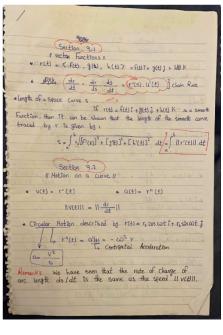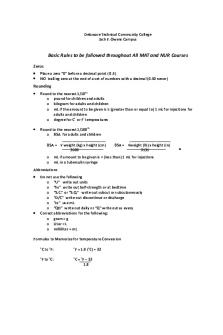Rules for naming alkynes and MORE-2018 PDF

| Title | Rules for naming alkynes and MORE-2018 |
|---|---|
| Author | Michael Foster |
| Course | Organic Chemistry I |
| Institution | Georgetown University |
| Pages | 3 |
| File Size | 273.6 KB |
| File Type | |
| Total Downloads | 81 |
| Total Views | 142 |
Summary
Rules for naming Alkynes...
Description
RULES for naming ALKENES/ALKYNES in Combination with other groups: (Prefix-Base-Suffixes) Simple alkynes are named exactly the same as alkenes, but with the suffix of -yne. Though, since there is no cis/trans or E/Z stereochemistry about the triple bond, their naming is more straightforward, with the parent simply being the LONGEST chain (cycles must be named as parent if present) regardless of the presence of multiple bonds and the locator numbers assigned to give the lowest set to the multiple bond position(s); only if two numbering choices give the same set of locator numbers for the multiple bonds will alkene take priority over alkyne. We often encounter molecules with “principal groups” that are deemed more important than alkenes or alkynes for naming. We also encounter molecules that may simultaneously contain multiple functional groups (e.g. simultaneously an alkene AND and an alkyne AND an alcohol, etc.). The following considerations dictate the naming rules. 1) Locator numbers are, of course, used to indicate the positions of substituents, double bonds, triple bonds, or other “principal groups” locations. According to IUPAC rules, certain “principal groups” (e.g. alcohols) take priority over multiple bonds and the suffix of the name will be given to these groups, while lower priority groups must be named as substituents. A partial IUPAC priority list for principal functional groups that take priority over alkenes and alkynes is the following, with highest priority on the left (see the rear inside cover of your text): Group: carboxylic acids esters aldehydes ketones alcohols amines____ Suffix: “oic acid” “oic acid alkyl ester” “al” “one” “ol” “yl amine” Substit: carboxy alkoxy carbonyl formyl oxo hydroxy amino 2)
So, for compounds containing double/triple bonds and no “higher precedence” principal groups, simply number the carbon atoms of the longest chain (or cycle; the cycle takes precedence) so as to give the lowest set of locator numbers to the multiple bonds entities. The positions of double bonds and triple bonds will always be indicated as suffixes. - If (and only if) there’s a tie in the possible locator numbers, the alkene will take precedence over the alkyne in being given the locator numbers. 3) For compounds containing principal groups with higher precedence to alkene/alkynes, the main chain MUST be assigned to INCLUDE the greatest possible number of the highest priority group, and the locator numbers of these groups should be assigned to give lowest possible set to the highest priority group. The positions of any double/triple bonds, and other functional groups will be dictated accordingly (and the double/triple bonds will still be named as suffixes if part of the parent chain), and the positions of lower priority functional groups must be named as substituents, using prefixes according to the tabulated convention above. 4) Follow normal steps for stereochem/putting substituents in alph. order and writing the name in the Prefix-Base-Suffix format. In the name, multiple suffixes are listed as #-en-#yn-#-principal_group_suffix. If the name ends with an “en” or and “yn,” add an “e” to give “ene” or “yne.” If the principal group must be at the beginning or end of the chain, by definition, we drop the locator number (e.g. carboxylic acids, aldehydes, esters)
Determining the parent/base name:
Base = Longest chain/cycle that CONTAINS the highest priority group! Base = Simply the longest chain or largest cycle (cycle > chain)
Always named as substituents
(E)-6-(but-2-enyl)-undec-4-yne (must pick the longest chain, alkene is a substituent; since no stereochem is indicated at 6 position, the name implies it is a racemic mixture)
(E)-5-propyl-oct-2-en-6-yne (not (E)-4-propyl-oct-6-en-2-yne; since no stereochem is indicated at 5 position, the name implies it is a racemic mixture)
(E)-oct-6-en-2-yn-4-ol (alcohol is most important, so “4-ol is better than 5-ol”, alcohol is also named as the final suffix; no stereochem indicated at 4 position, implying it is a racemic mixture)
2-butylhexan-1-ol (main chain must contain OH)
Note that some of the following structures have chirality centers. If specific 3D information were given, we would have to include the corresponding R/S configurational information in the parentheses, along with the E/Z information.
(alkene > alkyne)
(NOTE: eek, alkyne should not look bent)
(minimize locator numbers of multiple bonds)
(both ways octyl, most multiple bonds)
(length of chain is king for hydrocarbons)
Here’s a crazy one! (you won’t be expected to name ones this tough, but the others are fair game)...
Similar Free PDFs

Rules for naming compounds
- 2 Pages

Rules for naming alkanes-2018
- 3 Pages

Naming Amines and Amides rules
- 3 Pages

Naming Compounds-Rules
- 13 Pages

Halo Alkenes and Alkynes
- 7 Pages

Drawing and Naming Alkanes
- 3 Pages

all rules for 233
- 15 Pages

Game Rules for cricket
- 6 Pages

Math Rules for Nursing
- 2 Pages

Rules FOR Significant Figures
- 2 Pages
Popular Institutions
- Tinajero National High School - Annex
- Politeknik Caltex Riau
- Yokohama City University
- SGT University
- University of Al-Qadisiyah
- Divine Word College of Vigan
- Techniek College Rotterdam
- Universidade de Santiago
- Universiti Teknologi MARA Cawangan Johor Kampus Pasir Gudang
- Poltekkes Kemenkes Yogyakarta
- Baguio City National High School
- Colegio san marcos
- preparatoria uno
- Centro de Bachillerato Tecnológico Industrial y de Servicios No. 107
- Dalian Maritime University
- Quang Trung Secondary School
- Colegio Tecnológico en Informática
- Corporación Regional de Educación Superior
- Grupo CEDVA
- Dar Al Uloom University
- Centro de Estudios Preuniversitarios de la Universidad Nacional de Ingeniería
- 上智大学
- Aakash International School, Nuna Majara
- San Felipe Neri Catholic School
- Kang Chiao International School - New Taipei City
- Misamis Occidental National High School
- Institución Educativa Escuela Normal Juan Ladrilleros
- Kolehiyo ng Pantukan
- Batanes State College
- Instituto Continental
- Sekolah Menengah Kejuruan Kesehatan Kaltara (Tarakan)
- Colegio de La Inmaculada Concepcion - Cebu





